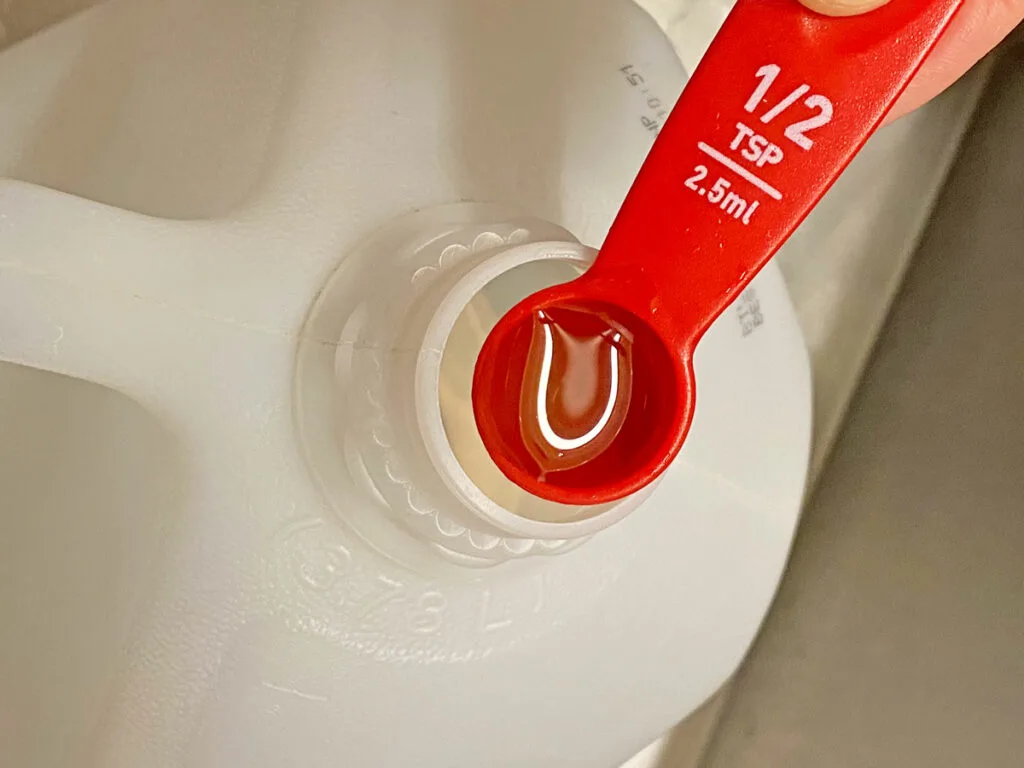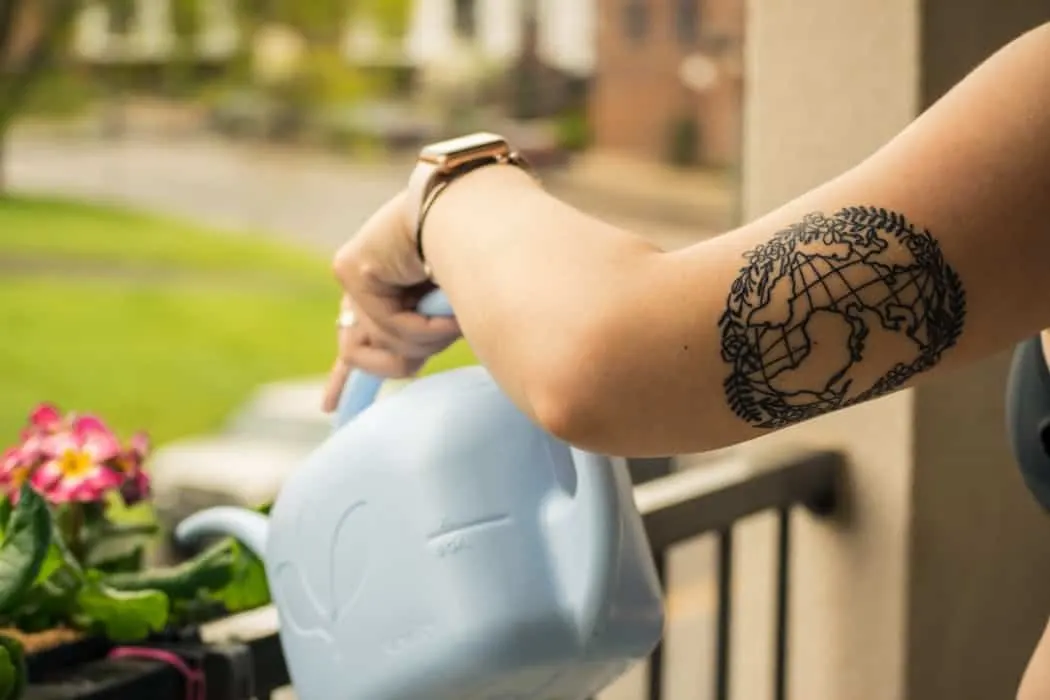Some of the links in this post may be affiliate links.
So you brought home that beautiful dream plant of yours, and at some point you noticed the dreaded brown and crispy edges on the leaves. There are actually several reasons why this happens. In this post, I will talk about 6 different reasons why your plant leaf edges are turning brown and crispy!

As with any diagnosis, I will provide you with some information and you will have to determine the cause based off of your houseplant practices.
Table of Contents
1. Underwatering
Underwatering is one cause of why your houseplants may be exhibiting dry and crispy leaves.
Often times, if you let your houseplant’s soil get bone dry, especially for extended periods, the lower leaves will typically turn brown and crispy. Either just the edges, or even the whole leaf.
You can also just have brown leaf lips if you are not properly watering. If you are not thoroughly soaking your soil when you water, the presence of dry soil pockets in your pot will be problematic.
If you routinely continue this type of treatment, the roots in the dry pockets of soil will eventually die and contribute to brown leaf tips, or worse!
How Not to Underwater
Always throughly soak your soil! If you need to, take your plant to the sink and thoroughly soak it. Let all the water drain away, and then place your plant back in its growing location.
Try not to let your houseplant’s soil go too dry for too long.
Of course, it depends on the plant. Some plants like to go completely dry, such as cactus and succulents.
But even they have their limits! You can easily deflate and dehydrate succulents by keeping them dry for too long.
For most leafy, tropical plants that are native to jungles, a good rule of thumb is to soak the soil, and then wait until the top 1/2 inch or inch of the potting mix is dry before watering again.
Get to know the growing needs of your specific plant.
2. Overwatering
Overwatering is a tricky term. In fact, I wrote a whole blog post on what overwatering really means.
Be sure to check it out. It is important because the term is often misused and the incorrect interpretation can cause a lot of issues!
If you have “overwatered” your houseplant, this can cause the roots to rot.
Ironically, by the roots rotting, this means that the plant is not able to take moisture from the roots to the stems and leaves. In the end, this essentially is “dehydrating” the leaves and causing brown tips!
How Not to Overwater
Never let your houseplant sit in standing water for an extended period of time. This can cause root rot!
Don’t water by a calendar. Water when your plant needs to be watered!
If you tend to water weekly, but you find that the surface of the soil is still moist, then don’t water!
3. Tap Water Quality and Houseplants
Depending on the tap water in your area, unless it is particularly hard, it will be fine in many cases. I have been using tap water my whole life for my plants and haven’t had any major issues at all.
There are some things to avoid though.
If you have a water softener system that uses sodium, this is toxic to plants, so please avoid this!
When I went through the master gardener’s online program from the Oregon State University extension, I learned some interesting things about water quality.
According to this program, chlorine in tap water won’t do much harm to your plant.
However, the fluoride found in tap water in many areas will be problematic for some plants.
Spider plants (Chlorophytum), corn plants (Dracaena) and some palms are sensitive and will get brown tips from fluoride.
How to Improve Water Quality for Your Plants
If you have ultra-hard tap water, or you use a water softener system, you will need an alternate source of water.
Consider maybe installing a rain barrel to collect water.
Or if you don’t have that many plants, you can use a water filtration system or buy gallons of filtered water.
4. Your Plant May Need Repotting!
Have you ever had a plant that looked great and had no brown tips? Nothing changed with your routine care and your conditions. But suddenly the brown tips seem to appear out of nowhere?
Your plant may desperately need to be repotted!
When you have a plant that is severely potbound, it will be difficult to keep up with watering it effectively.
You will find that it is hard to keep up with watering needs of a potbound plant.
In addition, for a plant that is REALLY potbound, there will be little room for water if the roots are in tight quarters.
As a result of this, the plant roots will take in the water that they can, and essentially when the water “runs out” on its way as its traveling from the roots to the stems and leaves, there won’t be enough water to travel to the leaf tips, and thus they will turn brown.
This phenomenon happened in quite a dramatic fashion with my cast iron plant.
It was a gorgeous, full specimen, and then suddenly I noticed the dreaded brown leaf tips!

I should have heeded my grandmother’s warning. She told me to repot it every single year.
Now, she may have done overboard by doing it every year, but she had a valid point!
I’ve had my plant in the same pot for a few years, and it is definitely time to repot.
I have also noticed this phenomenon with my peace lilies. One was perfectly green and beautiful, and then suddenly the brown leaf tips happened.

Tips on Repotting Houseplants
There are many signs that your houseplant needs to be repotted. One is that roots are coming out of the drainage holes.
But there are many other indications that your plant is pot bound. You’ll need to know how to determine if your plant needs to be repotted. Check out my blog post on exactly that topic.
I also have another blog post where I demonstrate exactly how to repot a peace lily. These tips can be applied to the majority of houseplants.
5. Overfertilizing Your Houseplants
If you overfertilize, what happens is your plant roots will become damaged.
And if your plant roots are damaged, they won’t be able to take water up effectively to distribute to the leaves, and therefore causing brown edges on leaves.
It’s as simple as that.
How Not to Overfertilize Your Plants
This may seem obvious, but I’ve seen people (and also MYSELF) make this same mistake. Not because I don’t know better, but because I’m sometimes lazy!
Make sure you measure whatever fertilizer you are using accurately. It can be easy to overadd fertilizer or create a solution that has a higher concentration than your plant likes!
I have my own measuring spoons that I use to measure out any fertilizer I use.
Also, if you are using fertilizer that you dissolve in water, make sure you accurately measure the amount of water. I use plastic jugs to make this easy.
Check out my fertilizer blog post for more information on types of fertilizers and how to use them.

6. Humidity is Too Low
Many plants like ferns, Calathea, Maranta, Anthurium, and many others like high humidity.
You may get occasional brown leaf tips if your indoor humidity is too low in your home.
However, before you go after humidity, make sure that you have good watering practices. This will go a much longer way in the health of your plant!
Good watering practices = healthy roots. And healthy roots = healthy plants.
Check out my watering myths blog post to be enlightened on the topic of watering.
So after you have your watering practices down pat, you can focus on humidity.
Tips to Increase Humidity
You guessed it. I do have a humidity blog post. But before you go read it, finish reading this post.
Here are some ways to increase humidity:
- Group plants together. Plants transpire water and will create their own micro climate.
- Set small plants on top of a tray with pebbles and water. The evaporating water will add humidity.
- Get a humidifier! My favorite humidifier of all time is in the humidity blog post. Be sure to check it out if you have been looking for an amazing humidifier.

I can’t get by without it anymore during our winters where we have bone dry air. (My skin hates low humidity more than my plants hate it!)
Also, be careful not to have your plants next to a heating vent! This will just scorch and dry your plants unnecessarily.
Did you notice that I didn’t include misting as ways to increase humidity? You’ll have to read the humidity blog post to see why. It just doesn’t do anything for humidity.
And be sure to read How to Increase Humidity for Houseplants to find out about my favorite humidifier ever. I’ve tested many, and I talk about my favorite by far. I know you will love it as much as I do!
I hope you found this blog post helpful. Have you discovered anything you’ve been doing to make your plants have brown and crispy edges? Comment below!







Jen
Monday 29th of July 2024
Hi there - I recently rescued a Davana fern from a big box store. It was the last one, no tag and clearly neglected (super dry soil). It is now thriving in my care but had several brown edged leaves when I bought it. Do you recommend cutting off the brown, crispy edges of the leaves, plucking the entire leaf & stem of the dry ones or something else altogether? I don't mind leaving them there if it will jeopardize the health of the fern. Thank you!
Raffaele Di Lallo
Wednesday 31st of July 2024
I would leave the leaves, but you can definitely trim the brown edges off. No harm in doing that! :-)
Sylvia
Thursday 21st of December 2023
I Love peace lilies but management is so hard for me... It's those drippy Leaves and brown tips ... Thanks for the information.
Raffaele
Thursday 21st of December 2023
They definitely hate to dry out and can be a bit touchy because of that! There are plenty of other plants that will suit your lifestyle.
Janice
Saturday 29th of July 2023
This was very acknowledgeable and I enjoyed the blog. Thank you.
Raffaele
Saturday 29th of July 2023
Glad you enjoyed it Janice!
Peggy
Thursday 23rd of March 2023
WOW!!! Just what I am looking for! I know I will be visiting your other blogs. Thanks
Raffaele
Friday 24th of March 2023
Glad you enjoyed it Peggy!
Lana smith
Thursday 8th of December 2022
Your information was very helpful. Thank you
Raffaele
Thursday 8th of December 2022
Glad you enjoyed it Lana!